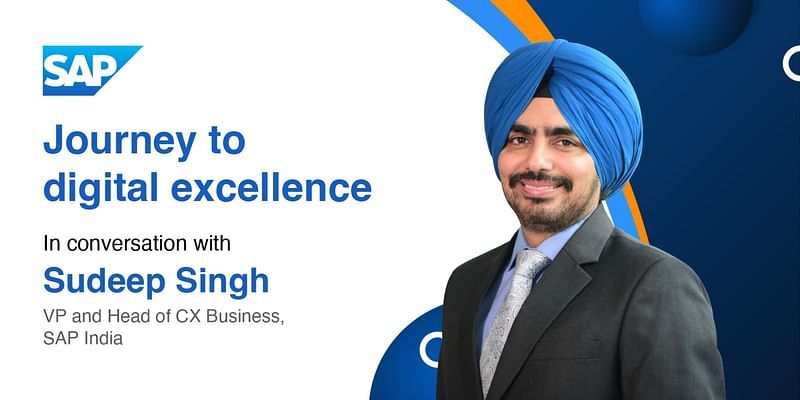
In the ever-evolving digital transformation landscape, understanding the nuances of consumer engagement, data privacy, and the strategic use of technology is paramount.
Sudeep Singh, VP and Head of CX Business at SAP India, brings a wealth of experience in steering digital transformation efforts for both enterprises and startups.
In this exclusive interview, Singh shares his perspectives on the distinctions in consumer engagement strategies between large conglomerates and startups, the impact of the Digital Personal Data Protection Bill, 2023 (DPDPB) rollout on startups, and crucial strategies for direct-to-consumer (D2C) brands to enhance customer loyalty.
Edited excerpts from the interview:
YourStory: Having played a pivotal role in steering digital transformation efforts for both large enterprises and startups, could you shed light on the distinctions in consumer engagement strategies between these two types of entities?
Sudeep Singh: One of the foremost principles we follow, which is also consistent with prevailing trends, is that most innovation happens in the B2C space first and then flows to B2B. Once they mature in the consumer space, larger enterprises look at absorbing those technologies and see how they will impact the B2B scenario.
In the startup space, again, B2C companies are initial adopters of these technologies. Conversely, a B2B company, whether a startup or a large enterprise, looks at the maturity of these technologies and then starts absorbing them into its own ecosystem.
The essence of digital transformation is predicated on two key parameters. One is how much impact one creates on the revenue if one introduces a particular technology. And the second, how much can the business save by introducing a technology or both. So, unless the project impacts a revenue base or a cost base, it doesn’t get categorized as digital transformation.
YS: Let’s talk about the DPDP rollout. What is your sense of the startup world’s reaction to it? How should scaleups prepare for the rollout, especially concerning managing customer consent and data privacy?
SS: Startups in the B2C space are already sensitised, particularly due to their interactions with global conglomerates, such as ours, so there should not be any resistance. The Indian startup ecosystem is mature, and they operate at scale. So, I think there should be acceptance.
As far as managing consent and data privacy is concerned, any scaleup needs a powerful platform. This has multiple aspects. First is the ability to identify the customer uniquely, second is the ability to capture the consent and preferences of the consumers, and the third – and most important aspect – is how one enforces it across the organisation.
SAP has been actively involved in this realm for the past five years, particularly following the acquisition of Gigya, an industry leader in consent capture and pivotal to the rollout of the General Data Protection Regulation (GDPR) in Europe. The SAP Customer Data Platform, as it is known today, finds its origin in this acquisition. In essence, an integrated platform is imperative, one that activates and enforces these rules as mandated by the law across the organisation.
YS: In the age of digital transformation, how can startups effectively implement omnichannel engagement strategies to enhance customer experiences and drive growth?
SS: It is imperative to Identify customers and ascertain their preferred communication channels. Simultaneously, it is crucial to track innovation happening in the industry. Irrespective of the social medium or a new conversational platform, it is paramount to be updated on the medium through which the business can connect with customers.
Another equally important element is the content passing through that medium. If one crack both the preferred channel and what content goes into that channel, the business’ omnichannel strategy is a winner.
However, content management often poses a challenge for most companies. They need sophisticated platforms, especially the likes of a Customer Data Platform, which are required to create the specific review and make it happen much faster.
Unfortunately, we tend to look at organisations in silos of a back office and a front office. But the key to creating context and content for the customer to engage is to really look at it as a ‘one office’ where the backend, supported by SAP ERP, and the front office, powered by SAP Customer Experience Solutions, seamlessly talk to one another. A ‘one-office’ approach is required for the entire organisation to come together.
YS: What are the key strategies or tactics that D2C brands should focus on to increase the lifetime value of their customers? Are there any specific technologies or approaches that D2C startups can leverage to enhance customer retention and loyalty?
SS: Continuing what we have discussed thus far, one needs to double down on a single view of the customer. If the customer is unhappy, one can try to introduce an intervention with some kind of benefit for the customer to engage again.
And, now, with tech and AI, marketers can have a 360-degree view of the customer, the age group, income profile, kind of buying, etc. All this information helps the marketer analyse better and work on retention strategies.
In summary, a comprehensive customer profile empowers companies to proactively engage with customers. The ability to identify and address customer concerns, aided by a detailed customer profile, is pivotal in cultivating customer loyalty across the customer base.
YS: How crucial is selecting and implementing the right martech stack for startups aiming to scale rapidly? What factors should they consider? Can you highlight some key martech tools or platforms that have proven beneficial?
SS: Scaleups today need tools like Customer Data Platform (CDP), which encompasses certain fundamental components. Firstly, it possesses the ability to collate all customer interactions within the organisation, regardless of the system or department responsible for these interactions, be it marketing, sales, customer service, complaints, or customer engagements, on social media platforms.
The second component is the ability to predict the next steps based on the view created. That is where machine learning and AI come in. There are so many different consumer preferences and types, and each consumer will have further action to be taken with machine learning in play.
The third component is execution. This is where CDP differs from typical data warehouses or data lakes used. CDP connects with downstream systems to execute outcomes given by machine learning with the understanding from a single view of the customer. Thus, in essence, the CDP becomes the link between all systems of your organization, and everything else is an extension.
YS: What advice would you offer to startups, particularly those in India, looking to navigate these challenges and seize opportunities in today’s competitive landscape? What emerging trends or technologies do you believe will have a significant impact on the areas of customer experience, data privacy, and scaling for startups in the near future?
SS: Startups have achieved significant milestones in building technologies and evolving some of these consumer-facing technologies that consumers have adopted and created new business models. I think larger organisations have struggled to do that with agility. But agility aside, my advice to startups would be that they need to also look at what larger organisations are doing in terms of scale.
By amalgamating these two facets of agility and innovation at scale, scaleups can attain accelerated growth and swiftly amass a broader customer base and augmented revenues.
In terms of emerging trends, definitely the spotlight is currently on generative AI, especially with the success of Chat GPT. This development is poised to revolutionise the manner in which organizations engage with their customers. Conversational interactions will proliferate, reducing the dependency on numerous contemporary technologies.



![Read more about the article [YS Exclusive] Gul Panag, Nikhil Vora, and Nimisha Nagarsekar invest in conscious-tech platform OneGreen](https://blog.digitalsevaa.com/wp-content/uploads/2022/04/Image92u5-1631682410521-300x150.jpg)
![Read more about the article [Morning Quote] I’ve failed over and over and over again in my life, and that is why I succeed](https://blog.digitalsevaa.com/wp-content/uploads/2023/04/michael-jordan-ftr-032818jpg1o8676a38nepk16tlhvel7rmwv-1681956905730-300x169.jpeg)





